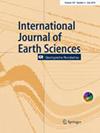Provenance of far-traveled nappes in the eastern Mediterranean (Uppermost Unit, Crete): constraints from U–Pb zircon ages of detrital and igneous zircons
IF 2
3区 地球科学
Q3 GEOSCIENCES, MULTIDISCIPLINARY
引用次数: 0
Abstract
Abstract New U–Pb ages of detrital and igneous zircons of the Uppermost Unit of Crete shed light on its provenance and on Eohellenic to Eoalpine imprints in the eastern Mediterranean. The detrital zircons of all nappes show Variscan ages and are characterized by a Minoan-type age spectrum, which is typical for the NE margin of Gondwana. Parts of the metasedimentary rocks are unexpectedly young. Their detrital zircon ages continue via the Permian until the Late Triassic, Middle Jurassic and Early Cretaceous. The high-grade metamorphic rocks of the Asterousia crystalline complex are likely equivalents of the low-grade metamorphic trench and fore-arc deposits of the Vatos nappe pointing to Late Cretaceous slab roll back. The presence of both late Permian detrital zircons and Late Cretaceous arc-type granitoids suggest that the Uppermost Unit of Crete is derived from the late Permian/Late Cretaceous magmatic belt situated north of the Sava–Vardar–Izmir–Ankara Suture in the Strandja–Rhodope area. To achieve their recent position on Crete, the nappes had to travel more than 500 km. The traveling path is well tracked by rocks of the Upper Cycladic Unit, which are similar to those of the Uppermost Unit of Crete. The large displacement of the Cretan nappes was controlled not only by nappe transport, but probably also by dextral strike–slip along the North Anatolian Fault Zone and related counterclockwise rotation of the Anatolian block since the Eocene. Graphical abstract

东地中海远行推覆体(克里特岛最上层)物源:来自碎屑和火成岩锆石U-Pb锆石年龄的制约
克里特岛上单元碎屑和火成岩锆石的新U-Pb年龄揭示了其物源和地中海东部古希腊-古阿尔卑斯印记。所有推覆体的碎屑锆石均表现为瓦里斯坎时代,具有典型的冈瓦纳北东缘米诺斯时代特征。部分变质沉积岩出人意料地年轻。它们的碎屑锆石年龄从二叠纪一直延续到晚三叠世、中侏罗世和早白垩世。Asterousia结晶杂岩的高品位变质岩可能相当于Vatos推覆体的低品位变质沟和弧前矿床,指向晚白垩世的板块回滚。晚二叠世碎屑锆石和晚白垩世弧型花岗岩的同时存在表明,克里特岛上单元来源于Strandja-Rhodope地区萨瓦-瓦尔达尔-伊兹米尔-安卡拉缝合带以北的晚二叠世/晚白垩世岩浆带。为了到达克里特岛最近的位置,推覆体移动了500多公里。移动路径被上基克拉迪单元的岩石很好地记录下来,这些岩石与克里特岛上单元的岩石相似。克里特岛推覆体的大位移不仅受推覆体搬运的控制,而且可能与始新世以来沿北安纳托利亚断裂带的右走滑和与之相关的安纳托利亚地块的逆时针旋转有关。图形抽象
本文章由计算机程序翻译,如有差异,请以英文原文为准。
求助全文
约1分钟内获得全文
求助全文
来源期刊

International Journal of Earth Sciences
地学-地球科学综合
CiteScore
4.60
自引率
4.30%
发文量
120
审稿时长
4-8 weeks
期刊介绍:
The International Journal of Earth Sciences publishes process-oriented original and review papers on the history of the earth, including
- Dynamics of the lithosphere
- Tectonics and volcanology
- Sedimentology
- Evolution of life
- Marine and continental ecosystems
- Global dynamics of physicochemical cycles
- Mineral deposits and hydrocarbons
- Surface processes.
 求助内容:
求助内容: 应助结果提醒方式:
应助结果提醒方式:


